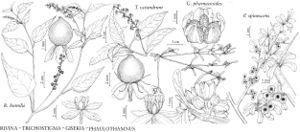Difference between revisions of "Trichostigma octandrum"
in H. G. A. Engler, Pflanzenr. 83[IV,39]: 109. 1909.
Common names: Hoopvine
Illustrated
Basionym: Rivina octandra Linnaeus Cent. Pl. II, 9. 1756
FNA>Volume Importer |
imported>Volume Importer |
||
| (7 intermediate revisions by 2 users not shown) | |||
| Line 1: | Line 1: | ||
{{Treatment/ID | {{Treatment/ID | ||
|accepted_name=Trichostigma octandrum | |accepted_name=Trichostigma octandrum | ||
| − | |accepted_authority=(Linnaeus) H. Walter | + | |accepted_authority=(Linnaeus) H. Walter |
|publications={{Treatment/Publication | |publications={{Treatment/Publication | ||
|title=in H. G. A. Engler, Pflanzenr. | |title=in H. G. A. Engler, Pflanzenr. | ||
| Line 8: | Line 8: | ||
}} | }} | ||
|common_names=Hoopvine | |common_names=Hoopvine | ||
| − | |basionyms={{Treatment/ID/ | + | |special_status={{Treatment/ID/Special_status |
| + | |code=F | ||
| + | |label=Illustrated | ||
| + | }} | ||
| + | |basionyms={{Treatment/ID/Basionym | ||
|name=Rivina octandra | |name=Rivina octandra | ||
|authority=Linnaeus | |authority=Linnaeus | ||
| + | |rank=species | ||
| + | |publication_title=Cent. Pl. II, | ||
| + | |publication_place=9. 1756 | ||
}} | }} | ||
|synonyms= | |synonyms= | ||
| Line 20: | Line 27: | ||
}}<!-- | }}<!-- | ||
| − | --><span class="statement" id="st- | + | --><span class="statement" id="st-undefined" data-properties=""><b>Plants </b>suberect, to 10 m, glabrous. <b>Leaves</b>: petiole 0.6–3.5(–5) cm; blade elliptic, elliptic-lanceolate or oblong to ovate, to 15 × 7 cm, base rounded to cuneate, apex acuminate or acute to obtuse. <b>Racemes</b> 5–10 cm; peduncle 1.3–3 cm; pedicel 3–10 mm. <b>Flowers</b> sepals white or greenish white to red or purplish in age, ovate to obovate, 3–6 mm. <b>Berries</b> 4–6 mm diam. <b>Seeds</b> black, lenticular, 4–5 mm.</span><!-- |
-->{{Treatment/Body | -->{{Treatment/Body | ||
| + | |phenology=Flowering spring. | ||
|habitat=Hammocks, roadsides, and disturbed sites | |habitat=Hammocks, roadsides, and disturbed sites | ||
|elevation=0-30 m | |elevation=0-30 m | ||
|distribution=Fla.;Mexico;West Indies;Central America;South America. | |distribution=Fla.;Mexico;West Indies;Central America;South America. | ||
| − | |discussion=<p>In the West Indies, strips of bark from Trichostigma octandrum are woven into attractive baskets; the flexible stems are used as barrel hoops. The young leaves, cooked in one or two waters, are said to be a nutritious vegetable.</p> | + | |discussion=<p>In the West Indies, strips of bark from <i>Trichostigma octandrum</i> are woven into attractive baskets; the flexible stems are used as barrel hoops. The young leaves, cooked in one or two waters, are said to be a nutritious vegetable.</p> |
|tables= | |tables= | ||
|references= | |references= | ||
| Line 35: | Line 43: | ||
-->{{#Taxon: | -->{{#Taxon: | ||
name=Trichostigma octandrum | name=Trichostigma octandrum | ||
| − | + | |authority=(Linnaeus) H. Walter | |
| − | |authority=(Linnaeus) H. Walter | ||
|rank=species | |rank=species | ||
|parent rank=genus | |parent rank=genus | ||
| Line 42: | Line 49: | ||
|basionyms=Rivina octandra | |basionyms=Rivina octandra | ||
|family=Phytolaccaceae | |family=Phytolaccaceae | ||
| + | |phenology=Flowering spring. | ||
|habitat=Hammocks, roadsides, and disturbed sites | |habitat=Hammocks, roadsides, and disturbed sites | ||
|elevation=0-30 m | |elevation=0-30 m | ||
| Line 48: | Line 56: | ||
|publication title=in H. G. A. Engler, Pflanzenr. | |publication title=in H. G. A. Engler, Pflanzenr. | ||
|publication year=1909 | |publication year=1909 | ||
| − | |special status= | + | |special status=Illustrated |
| − | |source xml=https:// | + | |source xml=https://bitbucket.org/aafc-mbb/fna-data-curation/src/2e0870ddd59836b60bcf96646a41e87ea5a5943a/coarse_grained_fna_xml/V4/V4_18.xml |
|genus=Trichostigma | |genus=Trichostigma | ||
|species=Trichostigma octandrum | |species=Trichostigma octandrum | ||
| − | |||
| − | |||
| − | |||
| − | |||
| − | |||
| − | |||
| − | |||
| − | |||
| − | |||
| − | |||
| − | |||
| − | |||
| − | |||
| − | |||
| − | |||
| − | |||
| − | |||
| − | |||
| − | |||
| − | |||
}}<!-- | }}<!-- | ||
-->[[Category:Treatment]][[Category:Trichostigma]] | -->[[Category:Treatment]][[Category:Trichostigma]] | ||
Latest revision as of 22:57, 5 November 2020
Plants suberect, to 10 m, glabrous. Leaves: petiole 0.6–3.5(–5) cm; blade elliptic, elliptic-lanceolate or oblong to ovate, to 15 × 7 cm, base rounded to cuneate, apex acuminate or acute to obtuse. Racemes 5–10 cm; peduncle 1.3–3 cm; pedicel 3–10 mm. Flowers sepals white or greenish white to red or purplish in age, ovate to obovate, 3–6 mm. Berries 4–6 mm diam. Seeds black, lenticular, 4–5 mm.
Phenology: Flowering spring.
Habitat: Hammocks, roadsides, and disturbed sites
Elevation: 0-30 m
Distribution
Fla., Mexico, West Indies, Central America, South America.
Discussion
In the West Indies, strips of bark from Trichostigma octandrum are woven into attractive baskets; the flexible stems are used as barrel hoops. The young leaves, cooked in one or two waters, are said to be a nutritious vegetable.
Selected References
None.
Lower Taxa
None.
